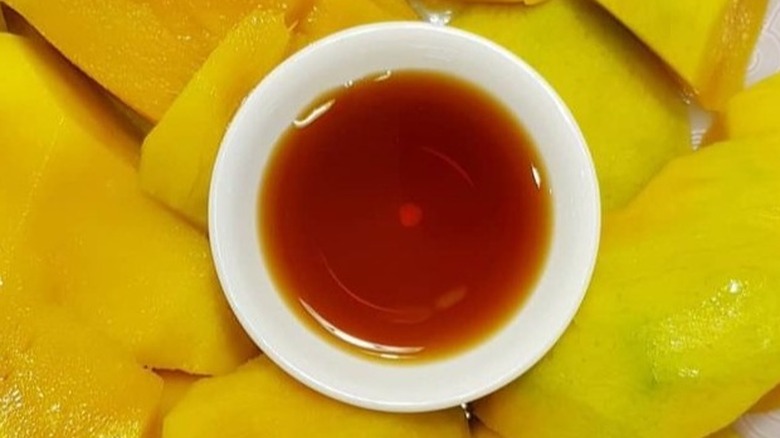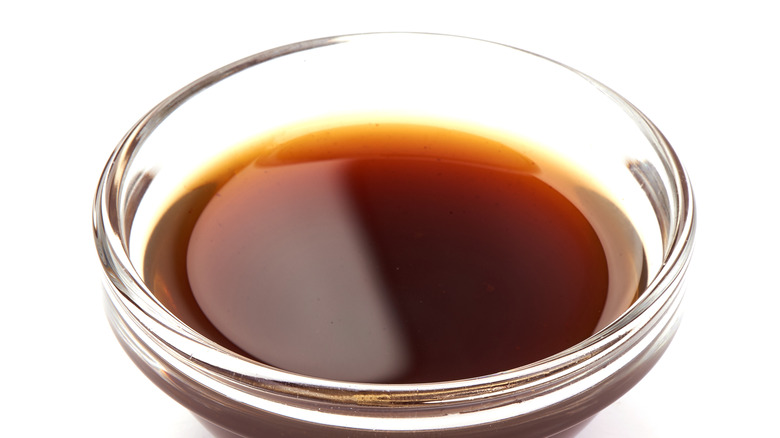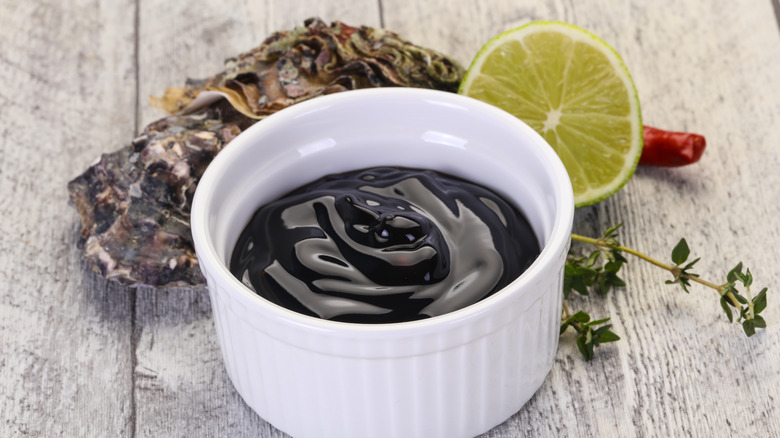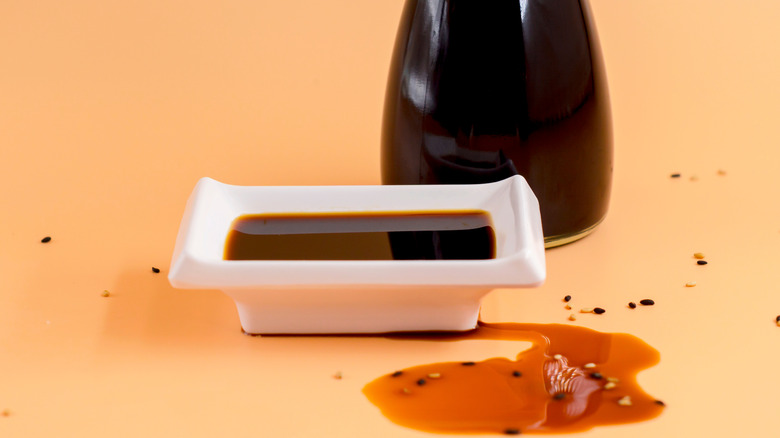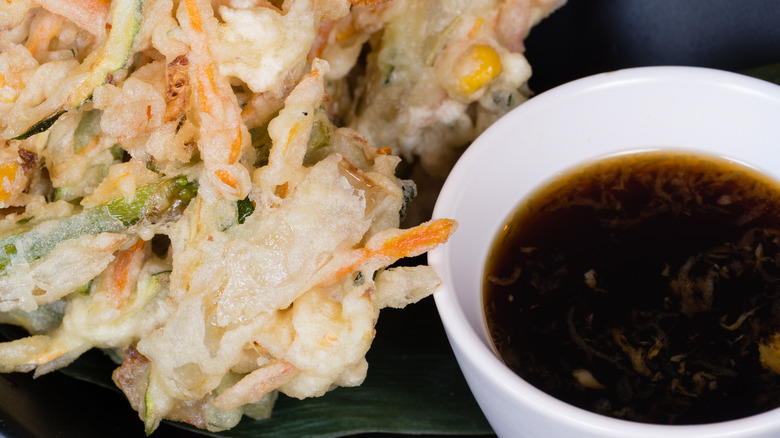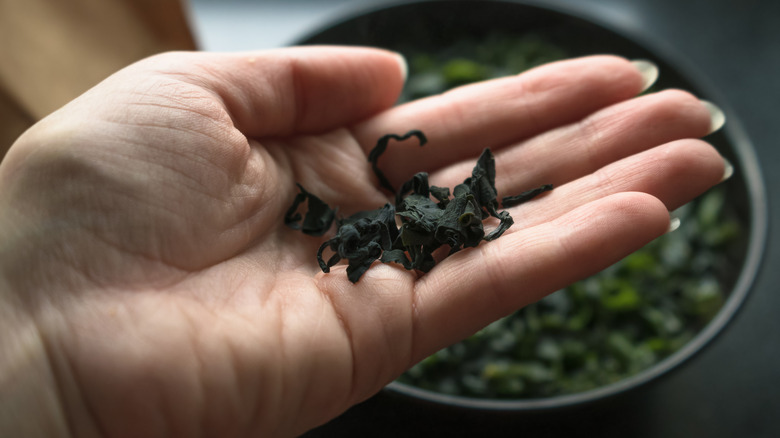7 Best Substitutes For Fish Sauce
It's known as nam pla in Thailand, nuoc mam in Vietnam, nam pa in Laos, ngan-pya-ye in Myanmar, and patis in the Philippines (via Devour). And while bottles of fish sauce are most commonly found in the specialty sections or in Asian supermarkets in most parts of the U.S., the pungent liquid is a star condiment in just about every corner where food is found across Southeast Asia.
Even though there are as many varieties (along with subtle taste differences) of fish sauce as there are food cultures in that part of the world, The Kitchn says the sauce is born pretty much the same way. Manufacturers typically start with small ocean fish like anchovy, which is then salted and allowed to ferment over time. They can use different types of fish such as sardines, mackerel, herring, or carp, and add other ingredients such as monosodium glutamate, sugar, and preservatives. Regardless of the tweaks, when fish sauce is served, it blesses dishes with a distinctive umami zing.
There are a number of reasons you might need a fish sauce substitute. You might be a vegetarian; you could be seafood-averse. Or you might love your fish sauce but made the mistake of storing it the wrong way. After all, opened bottles of fish sauce have been known to degrade if they are not properly stored (via Does It Go Bad).
In any case, if your fish sauce isn't in a position to help you out, there are a number of alternatives you might be able to find in your pantry.
1. Worcestershire sauce
Worcestershire sauce was first created in England and modeled after an Indian condiment (via BBC). Like many things, the condiment is the result of a happy accident. This anchovy-based sauce was said to have been formulated for a former colonial governor of Bengal, but drug store owners John Lea and William Perrins, who made up the batch, stored the liquid in the cellar and forgot about it until it was rediscovered two years later.
Because Worcestershire sauce also contains fish, and it is aged for 18 months, its flavor profile wouldn't be too dissimilar from that of Asian fish sauce. Worcestershire sauce, which can be swapped on a 1:1 ratio with fish sauce, has less sodium and has other ingredients like barley malt vinegar, tamarind extract, sugar, onions, as well as other unlisted spices. So, its flavor profile will be different from that of regular fish sauce.
2. Oyster sauce
Like Worcestershire sauce, oyster sauce is the result of a happy accident that took place in 1888 in Nanshui, China, when food stall owner Lee Kum Sheung accidentally left a pot of oyster soup on simmer for a few hours. When he returned, he discovered a thick, brown paste which the enterprising businessman decided to sell the umami-flavored goo to customers as a topping for rice, and a culinary staple was born (via Great British Chefs).
Like fish sauce, oyster sauce is made with an ocean staple, so you'll get the touch of umami that your dish might be looking for. But because oyster sauce is thicker, you'll need to add a bit of water to thin it out before using it as a substitute for fish sauce. But mind your sugar when you make this swap, since oyster sauce is sweeter than fish sauce. You can replace oyster sauce for fish sauce in a one-to-one ratio for marinades and stir-fries, per Spiceography.
3. Soy sauce
Soy sauce has been around for a while — for several thousands of years, in fact, and it has its roots in China where soy beans were fermented and salted to make a paste. That paste evolved to become soy sauce around the time of the Song dynasty, which was around from 960 to 1279 (via Culture Trip).
Like fish sauce, soy sauce has an umami quality, but it doesn't have that hint of the sea that fish sauce has. As such, Gourmet Sleuth recommends mixing one part soy sauce with four parts anchovy and simmering it in a saucepan for 10 minutes to get a similar flavor profile. But if you're vegetarian and want to skip the anchovy altogether, you can use one part soy sauce with one part rice vinegar.
4. Tamari
They are both made with fermented soybeans, but there's an important ingredient tweak between soy sauce and tamari. Soy sauce has wheat and tamari has none, making the latter the ideal condiment for those who have a gluten intolerance. Serious Eats describes tamari as being closer in taste to Chinese-style soy sauce, and it has a stronger flavor because it has more soybeans in it.
Tamari is also saltier than soy sauce, so when using it as a substitute for fish sauce, it might be best to start with a bit less and then adding more to taste. Serious Eats also says that tamari is best used as a dipping sauce, so it may be good to keep that in mind when deciding whether or not tamari will be a good substitute for fish sauce in your recipe.
5. Dried mushrooms
If you are vegetarian or vegan and fish sauce was never an option, there are many other recipes for fish sauce substitutes online, with Viet World Kitchen offering up a buying guide for vegetarian fish sauce, along with a recipe that makes use of pineapple juice, cassava syrup, and light soy sauce.
The Cook's Illustrated alternative looks to recreate the fish sauce flavor by starting with a homemade broth made with dried shiitake mushrooms, salt, and soy sauce. The broth is then boiled over medium heat until the liquid is reduced by half and becomes more concentrated. But unlike the fishy cousin it is meant to masquerade as, this concoction needs to be refrigerated and can only be stored for up to three weeks.
6. Seaweed
If you have a yearning for the taste of the sea but the thought of consuming anchovy doesn't appeal, there is the option of using wakame, an edible seaweed that is popular in both Japanese and Korean cooking. Do bear in mind that wakame is not nori, which is the seaweed sheet used to wrap different types of sushi with. Wakame can come dried or salted, in which case the latter will be found in the refrigerator section of a supermarket.
One Green Planet recommends mixing shredded wakame with water, garlic cloves, peppercorns, as well as soy sauce or tamari, and miso; the last ingredient is an option, because the mix is already salty without it. This mixture is a great fish sauce substitute.
7. Coconut aminos
For another option that is both vegan and gluten-free, you can always reach for a trusty bottle of coconut aminos, a trendy condiment made with sea salt and the fermented nectar of flowers taken from the coconut tree. Jessica Gavin describes coconut aminos as dark, thick, salty, with a hint of sweetness. While this condiment can be used in place of soy sauce, can coconut aminos be used in place of fish sauce too?
Coconut aminos will be sweeter, but it's still a good substitute for fish sauce. Plus, it contains a lot less sodium. You can use a one-to-one ratio between coconut aminos and fish sauce.
